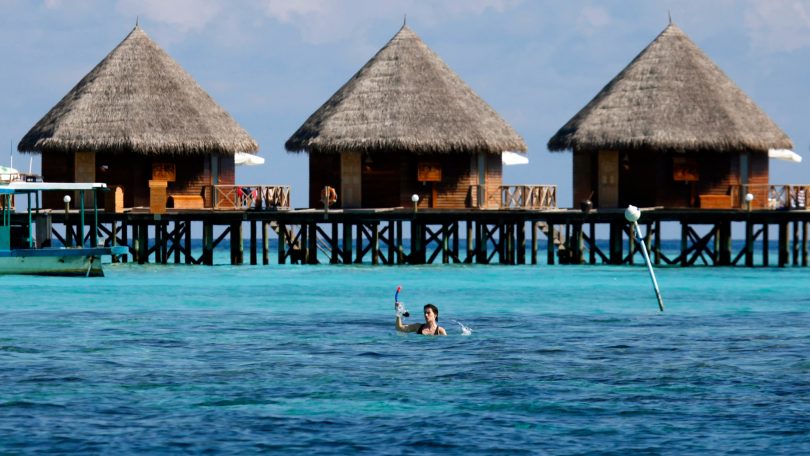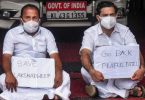BANGKOK — The Maldives is wading into unchartered waters as it restarts efforts to lure visitors to its necklace of remote, luxury island resorts, highlighting the idyllic isolation of the Indian Ocean and fewer entry restrictions in a novel approach to promote travel to virus-weary tourists.
At least 10 international airlines have reportedly lined up to resume flights to Velana International Airport, the country’s international gateway, when the South Asian archipelago reopens for foreign holidaymakers on July 15. These include Asian carriers SriLankan Airlines and Singapore Airlines along with Middle Eastern carriers Emirates and Qatar Airways, according to travel industry sources.
Holidaymakers will be offered a number of surprising welcome perks: no quarantine and a free 30-day, on-arrival visa. The only paperwork needed to disembark will be a health declaration card.
But the government is treading with caution as it sets the tone for its “new normal,” looking to assure high-spending tourists a healthy holiday in the country of 1,190 islands. “This includes health screening on arrival [and] physical distancing at ports, vessels and tourist facilities,” a senior official from the president’s office told the Nikkei Asian Review. “Visitors will be asked to report any symptoms while they are in the Maldives.”
Resorts need to meet new health standards set by the Health Protection Agency before being permitted to open, the official said. The regimen includes designated rooms for “isolation and quarantining of both staff and guests if required,” appropriate use of personal protective equipment, access to medical facilities, and the appointment of a COVID-19 safety manager in every resort.
“The Maldivian tourism industry is naturally set up for this global new normal,” the official added. “Today’s social distancing requirements are enhanced by our ‘one island, one resort’ concept.”
Resort owners have taken heed by rolling out new welcome measures for resuming tourism.
“Guests will check-in at their villas, minimizing the time spent in communal areas,” said Manih Ahmed, managing director of Kaimoo Travels and Hotels Services. Ahmed was referring to measures that will be taken by Summer Island Maldives, a four-star resort on an uninhabited island that is popular with European and Asian holidaymakers.
“[We’ll be] using technology to reduce the need for direct interaction with staff, increasing the frequency of cleaning, and disinfecting using electrostatic sprays in restaurants, bars and other high-contact areas,” he said.
South Asia’s smallest country, with a population of 400,000, has recorded 2,502 cases of COVID-19, with 2,180 recoveries and 13 deaths. Most of the cases have been in the densely populated capital of Male.
The pandemic has taken a huge toll on the economy after the country shut air and sea borders to tourists in late March. The closure drained the life of the largest foreign exchange earner in the $5 billion dollar economy, which enjoyed a healthy growth of 6.7% in 2018. At that time, tourism generated about 60% of foreign income.
In March, as the impact of the global shutdown spread in the wake of the pandemic, the Asian Development Bank warned that the Maldives would be the worst affected country in Asia. The Manila-based international institution estimated a 5.5% economic contraction for the Maldives — a $293.9 million hit.
By April, the World Bank echoed this sentiment, as the country saw tourist traffic collapse after a record 1.7 million arrivals in 2019. In the first quarter of this year, as fallout from the pandemic loomed, the Maldives only attracted 382,760 tourists, a sharp decline from the nearly 650,000 who vacationed during the same period the previous year, according to Maldivian tourism industry sources.
Financial analysts reckon the economic strain from COVID-19 exceeds previous external shocks, such as the slumps following the 2004 December tsunami and the 2008 financial crisis. “The economic shocks unleashed by the COVID-19 crisis are unprecedented,” Fazeel Najeeb, the former governor of the Maldives Monetary Authority, the central bank, told Nikkei.
“With no revenue coming in, tourist facilities are enduring a severe cash-flow crisis. …To forestall extreme outcomes, some have had to lay off employees, while others reduced wages,” he said. “As cash flow shrank, other financial commitments, including debt repayment, were also affected.”
The government stepped in with financial relief through its COVID-19 Recovery Scheme. “Under this scheme, over $27 million has already been disbursed,” said Tim Sawyer, CEO of the Bank of Maldives. “[We also introduced] a short-term financing facility for the tourism industry to support resorts and guesthouses, and introduced collateral-free working capital financing for businesses.”
According to the Ministry of Economic Development, an estimated 22,000 employees at resorts have been affected by the pandemic. Fishing communities, a key sector in the island economy that supplied their catch to resorts, have been scrambling to find other outlets as demand dried up.
But tourism has helped the country bounce back in the past, as the post-tsunami and post-financial crises have shown. For that, the Maldives is eyeing a return of tourists from China, the largest inbound market last year, accounting for nearly a fifth of holidaymakers.
“We are in conversation with Chinese authorities to determine if there are any particular pre-departure requirements that travelers must meet before traveling back to China,” said the official from the president’s office. “Pre-departure testing up to 48 hours before a flight can be arranged through resorts and health authorities.
Full details are available at the link below:
Source URL: Google News










